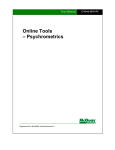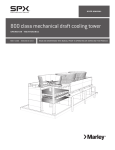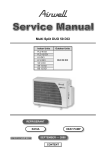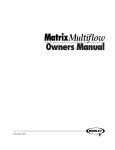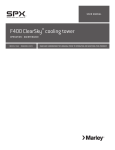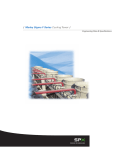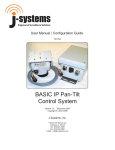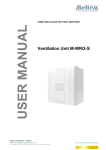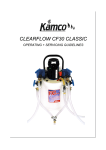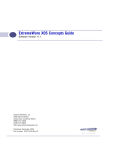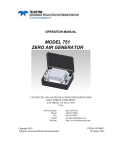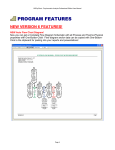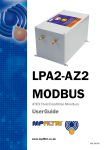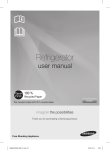Download Marley clearflow cooling tower cross flow application user manual
Transcript
/ ClearFlow Crossflow Application / ® User Manual / Contents / Note This manual contains vital information for the proper installation and operation of your ClearFlow plume control modules. Carefully read the manual before operation of the ClearFlow equipped tower and follow all instructions. Save this manual for future reference. Plume Characteristics ............................................................................ 3 Components ........................................................................................... 6 Specifications ......................................................................................... 7 Installation .............................................................................................. 8 Operation.............................................................................................. 10 Maintenance ......................................................................................... 13 Troubleshooting .................................................................................... 14 The following defined terms are used throughout this manual to bring attention to the presence of hazards of various risk levels, or to important information concerning the life of the product. Warning Indicates presence of a hazard which can cause severe personal injury, death or substantial property damage if ignored. Caution Indicates presence of a hazard which will or can cause personal injury or property damage if ignored. Note 2 Indicates special instructions on installation, operation or maintenance which are important but not related to personal injury hazards. / Plume Characteristics / Because of the evaporation that takes place in a cooling tower, the leaving airstream is saturated with water vapor. This plume of saturated air can be highly visible because it is usually warmer, and contains considerably more moisture, than the surrounding atmospheric air. As it cools to reach equilibrium with the ambient air, its excess water vapor condenses because cold air is incapable of assimilating as much moisture (specific humidity) as warm air. This condensed plume of moisture becomes visible as fog. The cooling of this plume also decreases its buoyancy—ability to rise. In many cases, particularly in adverse wind conditions, cooling plumes will remain at very low levels until they dissipate, often reinforcing ground level fogging. This is unacceptable in the vicinity of airports, and is of serious concern when their density and persistency can affect highway visibility. The density, persistency, and buoyancy of this visible plume is a function of the total amount of heat extracted from the water (by evaporation), the temperature at which the heat is extracted, and the temperature of the ambient atmospheric air. The greater the difference between the temperature of the warm exhaust air—plume—and that of the cool ambient air, ➠ 3 / Plume Characteristics / the more visible the plume. Visible plumes are typically much more dense and persistent in the wintertime than they are in the summer season. This is shown graphically in Figure 1 below, which relates the characteristics of the plume to the saturation curve of a psychrometric chart. In winter operation, air enters the tower at condition 1 and leaves saturated at condition 2. On leaving the tower, the air reaches equilibrium with the ambient air along line 2–1. In doing so, it remains in the supersaturated (fog) region of the chart for a considerable time. TU R CU ATIO RV N E 4 SPECIFIC HUMIDITY SA SUPER SATURATION (Fog) AREA 2 MIXING AIR ABOVE TOWER 3 SUPER HEAT (Non-Fog) AREA MIXING AIR WITHIN TOWER 1 Figure 1 DRY BULB TEMPERATURE Conversely, summer air enters the tower at condition 3, and exits saturated at condition 4. Returning to ambient conditions along line 4–3, the leaving airstream is never within the fog region. This classifies the plume visibility as wispy and short-lived, often not persisting beyond a few meters above the fan cylinder. Although higher heat loads can increase the persistency of summertime plumes, they never reach the density of those that form in the cooler seasons. Marley ClearFlow modules provide a means by which the plume leaving the tower can be made less visible, or more buoyant, or both resulting in reduced ground fogging. This is done by producing a stream of heated dry air that is mixed with the tower’s primary saturated airstream prior to its exit from the tower. This results in desaturation of the plume to the point 4 / Plume Characteristics / where it does not cross into the fog region on its way back to ambient atmospheric air conditions. That is to say, little or no condensation will be caused to occur. Visibility reduction is explained graphically in the Figure 2 psychrometric diagram. TIO RV RA R ING ST MIX FAN E ET OV W AB 1 DRY STREAM CU TU SA 4 M EA SUPER HEAT (Non-Fog) AREA TREAM 2 PLENUM S SPECIFIC HUMIDITY Figure 2 SUPER SATURATION (Fog) AREA E N The primary airstream enters the cooling tower’s wet section (fill) at condition 1, and leaves saturated at condition 2. Meanwhile, a secondary airstream enters the ClearFlow module at condition 1, gains heat (but no moisture content), and leaves at condition 3. These two airstreams mix together 3 DRY BULB TEMPERATURE along line 3–2, exiting the tower at condition 4. Returning to atmospheric conditions along line 4–1, the plume never (or barely) enters the fog region and is, therefore, neither dense nor persistent. Plume characteristics depend upon the application of the ClearFlow modules to the cooling tower. Fewer and smaller modules can increase the buoyancy of the plume (plume rise), but may not decrease plume visibility to the degree desired. More or larger modules not only increase plume buoyancy, but decrease its visibility significantly. In many cases, the plume can be made to become invisible within one or two fan diameters above the top of the tower fan cylinder. 5 / ClearFlow Module Components / COVER FRAME SPRAY HEADER PIPE INLET NOZZLES HEAT EXCHANGER SLEEVES DIFFUSION/SEAL TRAY DEBRIS BASKETS NOT SHOWN DAMPERS STRUCTURAL SUPPORT TUBES COLLECTION BASIN OUTLET Note—Dampers may not be utilized on some large crossflow towers. Also, the collection basin and outlet are normally unnecessary on large crossflow towers and therefore will not exist on those installations 6 / Specifications / General The frame, side panels, front and rear panels, and cross-bracing consist of pultruded fiberglass channels, panels, and square tubes. Cover The spray chamber cover consists of pultruded fiberglass interlocking panels. It is held in place with stainless steel bolts. Spray System Spray header piping is PVC. Nozzles and branch arms are injection-molded polypropylene. Nozzle and branch arm assemblies are attached to the header pipe with stainless steel straps. Diffusion/Seal Trays The diffusion/seal tray is vacuum formed ABS. Its purpose is to direct the incoming hot water into the separate heat exchanger sleeves where it will not come into direct contact with the air. Heat Exchanger Sleeves The heat exchanger sleeves are thermoformed .5 mm thick PVC. They separate the hot water from the air flowing through the ClearFlow module. They also provide the surface area, and promote the air turbulence necessary to maximize the heat rise of the air flowing through the modules without increasing its absolute humidity. Support Tubes The sleeve support tubes are stainless steel. Four of these tubes—two top, two bottom—pass through the heat exchanger sleeves to hold them firmly in their intended position. Collection basin The collection basin and outlet are molded FRP. Damper system The Dampers, and their linkage, are galvanized steel. 7 / Installation / ClearFlow modules are located on the cooling tower such that a portion of the hot water returning from the process, flows through the ClearFlow modules before returning to the cooling tower. Meanwhile, the incoming ambient air, induced by the tower’s fan, is divided—through the use of dampers or doors—between the ClearFlow modules and the normal wet-section of the cooling tower. In that situation, part of the incoming air goes only through the ClearFlow modules—and part goes only through the cooling tower fill. These two airstreams, one heated and dry, the other heated and saturated with moisture, merge in the plenum chamber below the fan and mix together. This leaving effluent mixture will have increased buoyancy and will be sufficiently desaturated to be less visible or in some cases invisible. Although ClearFlow modules can be operated year-round, they are usually activated only when they are considered to be needed. The primary reason why they are not typically used year-round is that operational modules (dampers open) reduce the amount of air flowing through the evaporational wet section of the tower. Unless the cooling tower has been specifically sized for year-round plume abatement, this may cause some degradation in thermal performance, perhaps at the very time (summer) when maximum thermal performance is most important to the operation of your system. In off-season (fall, winter, and spring) operation, the water temperatures produced by the cooling tower are usually sufficiently cold to make any performance degradation caused by the use of the modules unnoticeable. Figure 3 shows the probable arrangement of the modules for either of two situations. The modules on the left deliver their air to the tower's fan plenum area through a two-position air-control door, wherein the doors are either fully open or fully closed. This arrangement is typical of those installations where plume abatement is necessary only in the cooler months, and where control of the cold water temperature is not expected to be of great concern. On the other hand, the modules on the right have been fitted with multi-position air-control dampers which allow modulation of the dry air supply. This arrangement is typical of those installations where year-round plume abatement may be necessary, and the cooling water temperature is critical to your process. 8 / Installation / PLENUM CLEARFLOW MODULE WATER IN AIR CONTROL DAMPERS AIR CONTROL DOOR AIR FLOW DRY AIR AIR FLOW WET AIR WET SECTION FILL AIR FLOW AIR FLOW Figure 3 9 / Operation / Note The operating mode of a tower with ClearFlow plume abatement modules will vary with the need for plume abatement or enhanced plume buoyancy. Generally speaking, the modules will probably not be activated during the hottest months of the year, because of the scant visibility of a normal hot weather plume. During that period, when plume control is not needed, none of the circulating water should be directed through the modules—the module air dampers or air-control doors should be fully closed—and the tower should be operated as if the ClearFlow modules did not exist. Module Water Flow When the weather cools to the point where the plume begins to become more dense and persistent, and slower to rise, the appropriate portion of the incoming hot water should be diverted through the ClearFlow modules. In this mode, a portion of the hot water returning to the tower will flow through the modules before returning to the auxiliary spray system or to the tower's cold water basin. Module Airflow Once the appropriate water flow has been established through the modules, plume abatement and buoyancy is established by controlling the flow of air through the ClearFlow modules. Note Do not attempt to control plume characteristics by varying the water flow through either the tower or the modules. Zero module airflow = Visible less buoyant plume, but colder water When the dampers or air-control doors are shut, all of the air being moved by the fan flows through the cooling tower fill, providing the maximum evaporative cooling effect (coldest water)—but also creating the most visible, and least buoyant, plume. Full module airflow = Invisible or buoyant plume and warmer water When the dampers or air-control doors are fully open, a significant portion of the air being delivered by the fan flows through the ClearFlow modules. This introduces the maximum amount of warm, dry air into the tower's fan plenum, and achieves the maximum desaturation of the air leaving the tower—see Figure 2. In this operating mode, least visibility (and maximum rise) of the plume is achieved—but at the expense of somewhat warmer cold water from the tower. 10 / Operation / Damper Modulation On installations equipped with air-control dampers, the dampers may be modulated to achieve the best balance between coldest water temperature and maximum plume control. Closing the dampers provides colder water. Opening the dampers provides greater plume control. Generally speaking, it is best to start modulation from a fully closed position, opening the dampers only as much as is needed for acceptable plume rise or abatement. As the weather grows colder, damper opening will have to increase, reaching maximum opening on the coldest days of winter. Wintertime Module Operation When properly piped and maintained, wintertime operation will not present a problem for the ClearFlow modules. Unlike coil-type heat exchangers, ClearFlow modules are gravity-flow, non-pressurized, and self-draining. Accordingly, their PVC heat exchanger cores will not freeze up even during shutdown periods in the coldest weather. However, natural precipitation during freezing weather (snow, sleet, etc.) may cause ice buildup to occur on the blades and linkages of the air dampers. If allowed to build up unrestricted, this ice will render the dampers inoperable until such time as a natural rise in atmospheric temperature melts the ice. Since the coldest weather will necessitate maximum plume abatement, it is probable that ice buildup will occur when the module dampers are fully open. Also, it is very probable that the dampers will not have to be operated until some time after the weather moderates, and the need for maximum plume abatement reduces. If the dampers do have to be manipulated, however, the presence of ice will demand that care be exercised. Caution If your dampers are manually operated, resistance in the operating linkage will tell you if there is too much ice to allow proper operation of the dampers. Motor-operated dampers, on the other hand, should be checked for the presence of ice before the motor/actuator is allowed to operate. Otherwise, the dampers or damper linkages may be damaged. Do not attempt to adjust dampers if excessive ice buildup is present. 11 / Operation / Start-up Start-up of the cooling tower itself should follow the instructions in the User Manual supplied with your tower. The start-up steps below assume that the cooling tower is in full operation, and that the ClearFlow system is not operating, with water flow off and all air intake dampers closed. ClearFlow units should be turned on well before freezing conditions exist. 1. Open all valves related to the ClearFlow water system, and start the flow of hot water through the modules. Valves should be opened incrementally to prevent excessive flow from damaging the spray system. 2. Assure yourself that relatively equal water flow is going through all modules. Clear piping and nozzles as necessary. 3. Open all air-control dampers. When air is flowing equally through all modules, there should be a noticeable reduction in the density and persistency of the tower's plume. The cooler the weather, the more noticeable the change will be. Plume control Once the water flow has been established to the ClearFlow modules, it must not be manipulated as a means of adjustment of the plume abatement function. Only the flow of air through the modules should be subject to adjustment. 1. If plume abatement and/or plume rise is adequate, but colder water is required, reduce the proportion of airflow going through the ClearFlow modules. On air-control damper equipped modules, gradual closure of the dampers will achieve the desired result. 2. If the airflow through the modules has been reduced and greater plume abatement or buoyancy is needed, open the air intake doors or dampers to increase the hot dry air. Shutdown 1. Fully close all air-control dampers or air-control doors. 2. Shut off the water flow to the ClearFlow system. 3. Close all intake valves related to the ClearFlow system. If a dedicated pump supplies water to the modules, it is normally sufficient to turn the pump off without closing the throttling valves. The throttling valves are then properly set for subsequent operation. 4. If shutdown during freezing weather, drain system to prevent damage. Warning When working in the vicinity of the fan, or when working on dampers, the fan motor should be locked out and remain shut down until the work is accomplished and the threat of danger is over. 12 / Maintenance / Spray system The spray system is accessed by removing the fiberglass cover on top of the modules. The nozzles are large diameter and, therefore, not very susceptible to clogging. When necessary, however, the nozzles can be removed for cleaning. Note It is important to keep the module cover securely installed during ClearFlow operation. This prevents air from migrating into the water passages. Diffusion/Seal tray The diffusion/seal trays are covered by plastic mesh baskets designed to collect any Amertap balls, pipe scale, or other debris that passes through the spray system. These debris baskets should be inspected and emptied as often as experience proves it to be necessary. This can vary from location to location. Heat Exchanger Sleeves During routine cooling tower inspections, the modules should be inspected to see if airborne debris (dirt, leaves, etc.) has built up on the outside of the heat exchanger sleeves. Such debris will adversely affect the module's heat transfer capability and should be removed. If water hoses are used, they should be of relatively low pressure to prevent damage to the sleeves. Air-Control Dampers Under “Wintertime Module Operation”— page 11—the possibility of natural ice buildup is discussed. Do not attempt to operate dampers if excessive ice buildup is present. Torque limits usually can be set on electric operators—manual operators will require operator judgement of excessive force. Typical operation should not require damper adjustment under icing conditions. The dampers should be kept free of debris as discussed in “Heat Exchanger Sleeves” above. The bearings used in the air-control dampers require no lubrication. Air-Control Doors Air-control doors should be inspected each year prior to the beginning of plume abatement “season” to make sure thy are operable. 13 / Troubleshooting / Trouble Cause Remedy Plume is too visible, or rises sluggishly. Water is not flowing to modules. Open all valves in ClearFlow water system and start water flow. Check to see that equal water flow is going through all modules. Open all module dampers by an equal amount until desired plume control is achieved. See causes and remedies below. Dampers are closed, or are not sufficiently open. Water to modules is flowing down the outside of the heat exchanger sleeves. Water is splashing out of plume abatement modules. Atmospheric condition is more difficult Water to modules is flowing down the outside of the heat exchanger sleeves. than that for which the ClearFlow application was designed. Debris baskets are clogged. Water flow to module is excessive, causing overflow of the diffusion tray. Diffusion tray is out of place. Heat exchanger sleeves are out of place. Heat exchanger sleeves are leaking. Water is splashing out of plume abatement modules. Module spray system is clogged. Water flow to module is excessive, causing overflow of the diffusion tray. Diffusion tray is out of place. Heat exchanger sleeves are out of place. Cold water temperature is Cooling tower fans are not running at full too warm. speed. Dampers are open at the wrong time—or are open too far—causing air to bypass the fill. Something is wrong with the cooling tower—or it is being operated improperly. 14 See causes and remedies below. Open dampers as wide as they will go, and accept the amount of plume control produced. Remove spray chamber cover and empty debris baskets. Spray system of one or more modules may be clogged. Remove clogged nozzle and clear out debris. Balance water flow to all modules. If water flow is still excessive, throttle the flow to the modules. Reinstall diffusion tray correctly. Make sure that all structural support tubes are socketed in the side panels. Arrange heat exchanger sleeves such that the discharge slots in the diffusion tray discharge the water into the sleeves. Seal leaks in the PVC sleeves. Consult your Marley sales representative for technical assistance Remove and clean out the nozzle and branch arm assemblies. Balance water flow to all modules. If water flow is still excessive, throttle the flow of the auxiliary pump. Reinstall diffusion tray correctly. Make sure that all structural support tubes are socketed in the side panels. Arrange heat exchanger sleeves such that the discharge slots in the diffusion tray discharge the water into the sleeves. Switch fans to full speed operation. Dampers should be completely closed if no water is flowing through the modules. If water is flowing through the modules, the dampers should only be open far enough to accomplish plume control. Further opening merely diverts air from the fill unnecessarily. Refer to your operating curves in your User Manual. Follow operating and maintenance procedures outlined in your cooling tower User Manual. 15 ������������������������������������������������������������������������������������������������������������������������ �������������������������������������������������������������������������������������������������������������������� ���������������������������������������������������������� Manual 99-1427
















